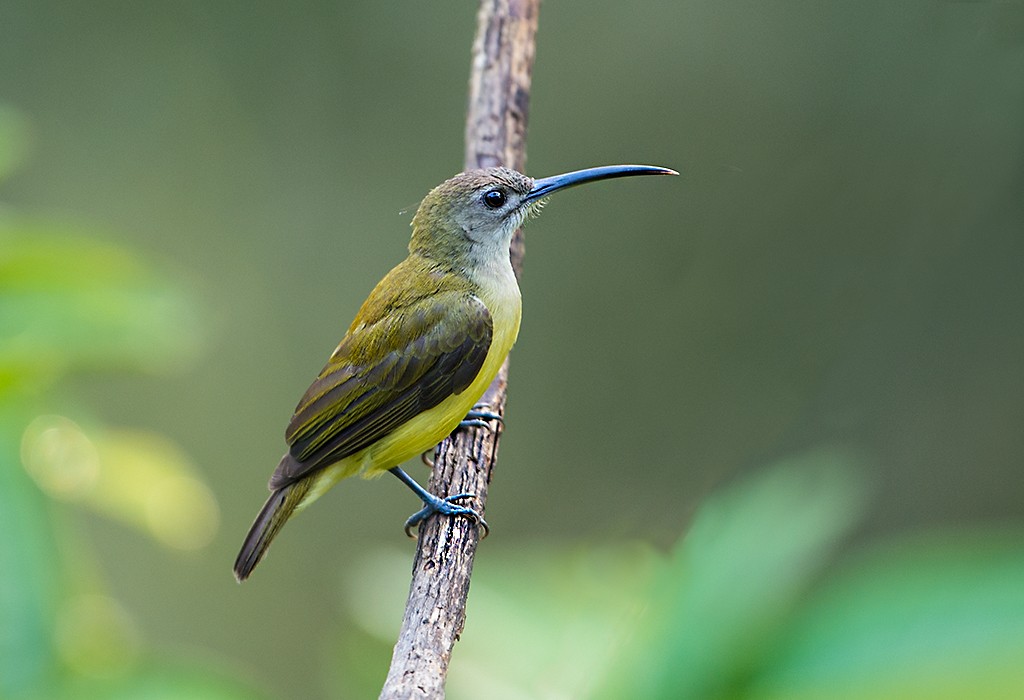Little Spiderhunter
A species of Typical Spiderhunters Scientific name : Arachnothera longirostra Genus : Typical Spiderhunters
Little Spiderhunter, A species of Typical Spiderhunters
Botanical name: Arachnothera longirostra
Genus: Typical Spiderhunters
Content
Description General Info
Description
The distinctive long beak set it apart from other sunbirds. The sexes are alike except for a paler base to lower mandible in the female. Male has all black beak. They are found close to their favourite nectar bearing trees, often species of wild Musaceae or flowers in gardens. They have a buzzy zick-zick call that is made regularly when disturbed or when foraging. The song is series of rapid chipping notes and these can go on for long periods. 
Size
16 cm
Colors
Black
Green
Yellow
Bronze
Gray
White
Life Expectancy
6 years
Nest Placement
Tree
Feeding Habits
Little Spiderhunter primarily consumes nectar, displaying a preference for wild bananas and other forest blossoms. Exhibiting distinctive behavior, it uses its long bill to extract this sustenance, frequently hanging upside down while foraging. It's especially adapted for feeding from tubular flowers.
Habitat
Little Spiderhunter thrives in subtropical and tropical forested areas, particularly within moist lowland and montane forests, including mangroves. Favoring lower altitudes, they are found beneath the forest canopy, frequenting understoreys, edges, as well as adjacent gardens and plantations rich in nectar-producing flora. Their elevation range spans from sea level to 2200 meters.
Dite type
Nectivorous
General Info
Feeding Habits
Bird food type
Behavior
They have been noted as good pollinators of wild banana species and several species of the ginger family and often visit Loranthus sp. (= Dendrophthoe sp.), Indian silk cotton tree and Indian coral tree for nectar. They are often seen in plantations in forest areas. Although they are more often seen in secondary forests or in clearings and appear to be tolerant of human activities, they have become extinct in some forest fragments. In Singapore they have gone locally extinct within the botanical garden. The breeding season in northeastern India is March to September but mainly May to August. In southern India it breeds from December to August. Two eggs are the usual clutch. The nest is a compact cup attached under a leaf of banana or similar broad leaved plant. The nest is suspended from the underside of the leaf using 150 or so "pop-rivets" of cobwebs and vegetable fibre, a unique method of using spider silk for animal architecture. It is suspected that Hodgson's hawk-cuckoo and violet cuckoo are brood parasites on this species in India. A species of haemosporidian, Leucocytozoon, has been noted in specimens from Malaysia. 
Distribution Area
The species is found in Bangladesh, Bhutan, Brunei, Cambodia, China, India, Indonesia, Laos, Malaysia, Myanmar, Nepal, Philippines, Thailand, and Vietnam. Within India, there are disjunct populations in the Eastern Ghats from Lamasinghi, Visakhapatnam and parts of Orissa) and the Western Ghats apart from the main distribution in north-east India that extends into Southeast Asia. A record from the Nicobar Islands is considered doubtful. Its natural habitats are subtropical or tropical moist lowland forests, subtropical or tropical mangrove forests, and subtropical or tropical moist montane forests. It is usually found below the canopy. They are also found in gardens, attracted especially by flowers that yield nectar. 
Species Status
Not globally threatened.
Scientific Classification
Phylum
Chordates Class
Birds Order
Perching birds Family
Sunbirds and spiderhunters Genus
Typical Spiderhunters Species
Little Spiderhunter 